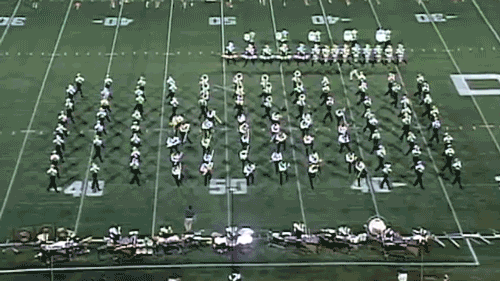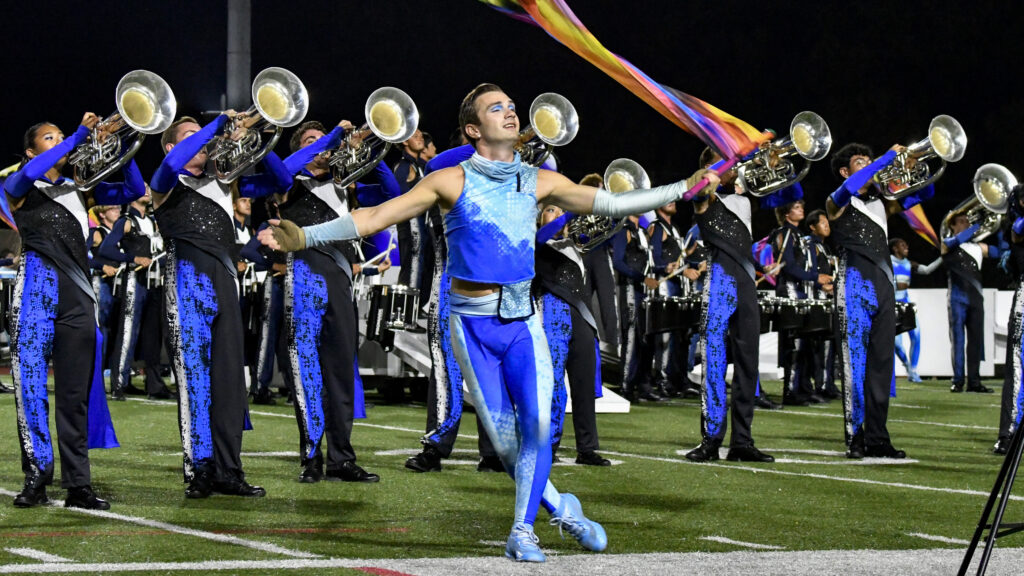The 1993 Drum Corps International World Championships in Jackson, Mississippi, was the last time in DCI history that saw two new corps break into the top-12 for the first time, with Glassmen and Colts appearing in the hot and sweltering Saturday night show after tying each other for 11th place in Semifinals.
Earlier in the season, Star of Indiana won 30 of its 34 shows, and then lost to the Cadets of Bergen County by a tenth of a point in the Finals, in what became Star’s last performance as a DCI corps. Unbeknownst to fans at the time, Star had already made plans for traveling with the Canadian Brass for the newfangled “Brass Theater,” which later evolved into the Tony-winning “Blast!”
During a rare early-season California tour to kick of the 1993 DCI Tour, members of the Cavaliers beat the Blue Devils at all six contests they faced each other and went on to win their first 12 shows of the season. But at the end of the season in Jackson, the corps finished fifth, behind Cadets, Star of Indiana, Phantom Regiment, and Blue Devils.

The Cavaliers’ 1993 production, “Heroes, A Symphonic Trilogy (Journey … Conflict … Triumph),” was an exploration of contemporary American wind literature.
The show opened with what was titled “The Symphonic Cantata,” a David Holsinger piece that was actually “The Death Tree,” the second of three movements of the composer’s epic “The Easter Symphony.” Composed in 1986, this movement is written for winds, percussion, mass choir and solo baritone voice, depicting the arrest, trial, and crucifixion of Jesus Christ. The other two movements were added by the composer at a later date.
Angular drill formations and melodies, intensely barbaric and emotionally draining, filled the opener from beginning to end. The piece was of the type of contemporary wind literature for which the corps had become known since the late 1980s. The music was such that few fans would be aware of the melodies prior to hearing them on the field, and it was a style not so thouroughly embraced by other corps at the time. However, the mood projected by these more obscure works was something aptly fitting The Cavaliers of that era.

The color guard members, attired in militaristic dress with white blouses and green sashes, also wore epaulets on their shoulders and sported a ribbon bar on their chests. At the end of this opening piece, a giant shield was formed in the drill, reminscent of a military medal that might be pinned along those award ribbons on the guard uniforms.
The center of the show focused on David Gillingham’s “Heroes, Lost and Fallen,” written in 1989, and subtitled, “A Vietnam Memorial.” Gillingham, a professor of composition at Central Michigan University, based the piece on one of his poems that reads, “Resolve this conflict/In hearts so sullen/And bring eternal peace/To the heroes, lost and fallen.”
The work opened mysteriously, much like the original, representing, according to the composer, “the uncertainty and instability before war.” A chorale alluded to “the world ideal of peace and serenity,” leading into “a sort of slow ‘march to war.’” A section of extreme musical cataclysm saw color guard members create emergency evacuation cots to carry wounded soldiers, immediately followed by the tenor drummers tossing rifles to the guard.

Snare drummers played with guiro-like drumsticks during an extended percussion break, one stick rubbing against the other to create a rasp effect. According to Gillingham, “The consonant choral of ‘peace’ reasserts itself, this time amidst the continuing conflict of war, suggesting that somehow ‘Good’ will triumph over ‘Evil.’ Both the chorale and the conflicting forces fade away and a short dirge-like section follows based on the opening motive of the chorale, signifying destruction, death and aftermath.”
During this final segment, the brass players ended playing backfield in a straight diagonal line that stretched from the upper left to the lower right corner of the field, with a concluding outburst by the timpanist “reminding us that the threat of war will always be present.”
The show’s closer featured “Morning Alleluias (for the Winter Solstice),” a piece written in 1989 by Ronald Nelson, perhaps best known to drum corps fans as the composer of “Rocky Point Holiday.”

Famed maestro Frederick Fennell commissioned the work after waking up in Hiroshima, Japan and finding his hotel room “ablaze with brilliant morning sunlight.” According to Fennell, he phoned Nelson from his room to tell him of the experience, offering a commission for the Tokyo Kosei Wind Orchestra at that moment. “As I lay in bed with so many dark thoughts also crowding in on that morning’s bright expectancies for the living day ahead, I know that these moments could only be celebrated at the triumph of the people of Hiroshima through the creation of a musical expression.”
The show ended with bright yellow and pink flags that were tossed over the temporary compressed horn line on both the horizontal and vertical axis. The profound sense of hope was in direct contradiction to the way the Gillingham piece ended. While the ending of that piece was a reminder “that the threat of war will always be present,” the body and ending of the Nelson work was a reminder that the hope for peace and tranquility will likewise also always be present.
1993 Overview

Michael Boo was a member of the Cavaliers from 1975-1977. He wrote about the drum corps activity for more than 35 years while serving as a staff writer for various Drum Corps International projects. During his lifetime Boo wrote for numerous other publications including an honors-winning book on the history of figure skating. He also was an accomplished composer. Boo passed away in 2020 and was inducted into the DCI Hall of Fame posthumously in 2021.





